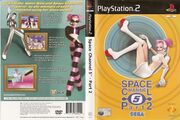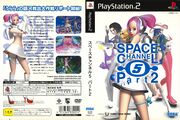Difference between revisions of "Space Channel 5: Part 2"
From Sega Retro
| Line 54: | Line 54: | ||
Other improvements include replacing the rendered backgrounds of the first game with real time environments. | Other improvements include replacing the rendered backgrounds of the first game with real time environments. | ||
| − | |||
| − | |||
| − | |||
| − | |||
| − | |||
| − | |||
| − | |||
| − | |||
| − | |||
| − | |||
| − | |||
| − | |||
| − | |||
| − | |||
| − | |||
| − | |||
| − | |||
| − | |||
| − | |||
| − | |||
| − | |||
| − | |||
| − | |||
| − | |||
| − | |||
| − | |||
| − | |||
| − | |||
| − | |||
| − | |||
| − | |||
| − | |||
| − | |||
| − | |||
| − | |||
| − | |||
| − | |||
| − | |||
| − | |||
| − | |||
| − | |||
| − | |||
| − | |||
| − | |||
| − | |||
| − | |||
| − | |||
| − | |||
| − | |||
| − | |||
| − | |||
| − | |||
| − | |||
| − | |||
| − | |||
| − | |||
| − | |||
| − | |||
| − | |||
| − | |||
| − | |||
| − | |||
| − | |||
| − | |||
| − | |||
| − | |||
| − | |||
| − | |||
| − | |||
| − | |||
| − | |||
| − | |||
| − | |||
| − | |||
| − | |||
| − | |||
| − | |||
| − | |||
| − | |||
| − | |||
| − | |||
| − | |||
| − | |||
| − | |||
| − | |||
| − | |||
| − | |||
| − | |||
| − | |||
==Physical Scans== | ==Physical Scans== | ||
Revision as of 07:02, 6 June 2012
| Space Channel 5: Part 2 | |||||
|---|---|---|---|---|---|
| System(s): Sega Dreamcast, Sony PlayStation 2, Xbox Live Arcade, PlayStation Network | |||||
| Publisher: Sega | |||||
| Developer: United Game Artists | |||||
| Genre: 3D Action | |||||
| |||||
|
CERO
Missing Parameter! |
Space Channel 5: Part 2 (スペースチャンネル5 パート2) is the sequel to the rhythm action game Space Channel 5, developed by United Game Artists and published by Sega. It was released on the Dreamcast (Japan only) and the PlayStation 2. It was released in Japan on February 14, 2002, Europe in February 12, 2003 (although it was not released in the United Kingdom) and in North America as part of a special edition package with the first game on November 18, 2003.
With its improved graphics, greater variety, and longer campaign, Part 2 is generally regarded as superior to its predecessor. However, it is much less well known than the original Space Channel 5 due to its belated and limited release outside of Japan.
The game, as with its predecessor, stars Ulala and has a cameo by Michael Jackson, known in this game as Space Michael.
Contents
Gameplay
Whilst the scoring system is much different from the first game, the core gameplay remains mostly unchanged from the first game. Ulala, the star of the game, must copy moves acted out by the opponent in time to the music by pressing the directional buttons. The ![]() button (
button (![]() button on the Dreamcast) is used when the opponents shouts "Chu!" and is sometimes used to shoot enemies or objects. Hostages can be rescued by pressing the
button on the Dreamcast) is used when the opponents shouts "Chu!" and is sometimes used to shoot enemies or objects. Hostages can be rescued by pressing the ![]() button (
button (![]() button), although in this game, it is now distinguished as "Hey!" and comes with its own dance move. New to this game is the ability to hold buttons down as a 'charged move' (When someone says 'Chuuuuu---', the player holds the
button), although in this game, it is now distinguished as "Hey!" and comes with its own dance move. New to this game is the ability to hold buttons down as a 'charged move' (When someone says 'Chuuuuu---', the player holds the ![]() button).
button).
Also new to the game is some segments that involve instrument battles. These are usually played using any directional button, as well as Chu and Hey.
Usually in the game, players have a set number of hearts, which varies depending on the situation. If they mess up a section, they lose a heart. If all hearts are lost, the game is over. In some sections, such as boss battles, stars replace hearts, the number of which is determined by the current rating (the higher the rating, the more stars will be available). If all stars are lost, the game is over.
The viewer rating percentage in the corner works as the score, which changes depending on how well the game is played and the number of hearts or stars at the end of a scenario. There are also secrets at certain points in between gameplay where players press buttons to make Morolians (the enemies from the last game, now allies), spring up from the corner. Players need to find all these secrets in a level in order to get a full 100% rating at the end. (The last level has a possible 200% rating.)
Elsewhere, there is a 100 stage battle mode, in which players have to play 100 consecutive lines, with only one heart. Some of the lines seem to resemble those found in the first game. There is also a 2 player mode, where one player controls directions and the other controls actions, and an alternate story mode where characters, costumes and dance moves are different.
Other improvements include replacing the rendered backgrounds of the first game with real time environments.
Physical Scans
Dreamcast version
PlayStation 2 version
External Links
- Dreamcast version official website on Sega.jp (Japanese)
- PlayStation 2 version official website on Sega.jp (Japanese)





